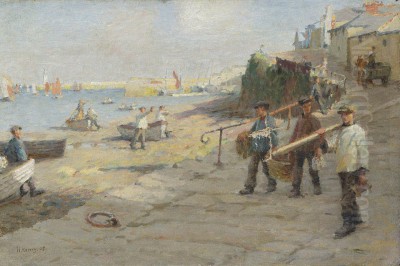
Harold Harvey stands as a significant figure in British art, particularly associated with the Newlyn School of painters. Born in Penzance, Cornwall, on May 20, 1874, and passing away just shy of his 67th birthday on May 19, 1941, Harvey dedicated his artistic life to capturing the essence of his native region. He was uniquely positioned as a Cornish native within a movement often characterized by artists who moved to the area. His work provides an invaluable visual record of the landscape, industries, and people of Cornwall during a period of considerable social and artistic change.
Harvey's connection to Cornwall was profound and lifelong. He was the son of Mary Bellringer Harvey and Francis McFarland Harvey, a local bank clerk. This grounding in the Penzance community likely fostered his deep understanding and empathy for the local way of life, which would become the cornerstone of his artistic output. Unlike many artists who sought formal education away from home early on, Harvey initially received his education within the family setting.
Early Life and Artistic Formation
Harvey's formal artistic training began locally at the Penzance School of Arts. This institution played a vital role in nurturing artistic talent within the region. A pivotal figure in his early development was Norman Garstin, an influential Irish-born painter who had settled in Newlyn and became a leading light in the second wave of the Newlyn School. Studying under Garstin provided Harvey with a strong foundation in observational drawing and painting, likely emphasizing the plein air principles and realist tendencies favoured by the Newlyn artists.
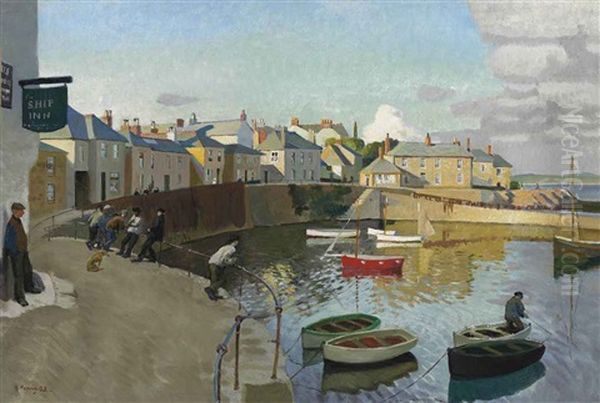
Seeking broader horizons and exposure to continental art trends, Harvey, like many aspiring British artists of his generation, travelled to Paris. Between 1894 and 1896, he enrolled at the prestigious Académie Julian, a renowned private art school that attracted students from across the globe. His Parisian education didn't stop there; he further honed his skills at the Académie Delécluse and the Académie Colarossi. These institutions offered rigorous training, often focusing on life drawing and academic techniques, but Paris also exposed him to the revolutionary movements of Impressionism and Post-Impressionism, which were subtly filtering into academic teaching and widely visible in galleries.
This period of study in Paris was crucial. While he absorbed the technical skills offered by the academies, the exposure to French art, particularly its emphasis on light, colour, and contemporary life, undoubtedly influenced his developing style. Upon returning to Cornwall, he brought back not just refined technique but also a potentially broadened perspective on how to depict the world around him.
The Newlyn School Context
Harold Harvey is intrinsically linked with the Newlyn School, an art colony established in the fishing village of Newlyn, near Penzance, in the 1880s. Artists were drawn to the area's dramatic coastal scenery, the quality of the natural light, and the perceived authenticity of the local fishing community's life. Founders and early prominent members like Stanhope Forbes, Frank Bramley, Walter Langley, and Thomas Cooper Gotch established a style characterized by plein air (open-air) painting, social realism, and often square brush techniques, capturing the hardships and heroism of everyday life.
Harvey, being a native of Penzance, represented a slightly later phase of the Newlyn School, sometimes considered part of its second generation, though his career spanned long enough to overlap significantly with both earlier and later figures. His teacher, Norman Garstin, was a key figure bridging these phases. Harvey’s work continued the tradition of depicting local life but gradually evolved, reflecting broader shifts in art towards the turn of the century and into the early twentieth century.
The Newlyn artistic community was vibrant and relatively close-knit. Artists shared studios, critiqued each other's work, and socialized together. This environment fostered a sense of shared purpose, even as individual styles varied. Harvey was an active participant in this milieu, contributing to the ongoing artistic dialogue and the reputation of Cornwall as a major centre for art outside of London.
Artistic Style and Development
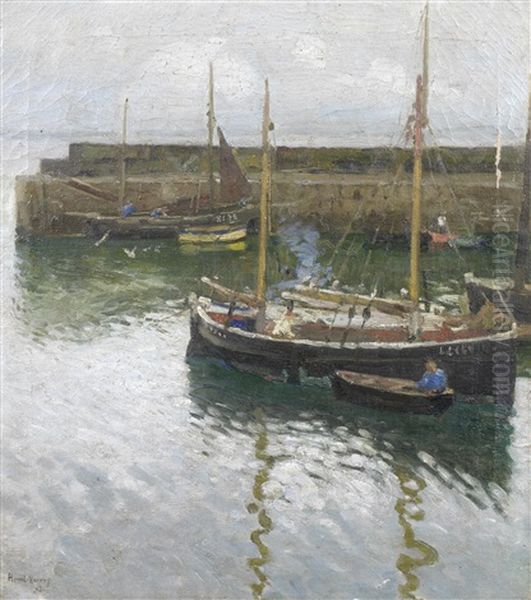
Harvey's early works firmly align with the tenets of the Newlyn School, displaying a strong sense of rural naturalism. He focused on depicting the working lives of Cornish people – the fishermen hauling their nets, farmers tending their fields, miners returning from the pits. These paintings often possess a sober palette and a detailed, realistic rendering that conveys the textures of worn clothing, weathered faces, and the rugged landscape. There's an honesty and lack of sentimentality in these early portrayals.
However, Harvey's style was not static. Influenced perhaps by his time in Paris and the evolving artistic climate, his work gradually incorporated brighter colours and a greater sensitivity to the effects of light and atmosphere, echoing aspects of Impressionism. While he rarely adopted the fully broken brushwork of French Impressionists like Claude Monet or Camille Pissarro, his later paintings often feature a higher key palette and a more luminous quality.
Towards the later part of his career, his style shifted again, moving towards a more decorative and refined aesthetic. Forms became more simplified and clearly defined, compositions sometimes flattened, and there was a greater emphasis on pattern and design, hinting at influences from Post-Impressionism or even early Modernist tendencies. Despite these stylistic shifts, his core subject matter remained rooted in Cornwall – its landscapes, harbour scenes, village life, intimate domestic interiors, and occasionally, religious themes interpreted through a local lens. He worked proficiently in both oil paint and watercolour.
Key Themes and Subjects
The dominant theme throughout Harold Harvey's oeuvre is Cornwall itself. He painted the harbours of Newlyn and Mousehole, capturing the jumble of boats, the reflections in the water, and the figures working on the quaysides. Mousehole Harbour and Boats at Newlyn Harbour are representative examples, showcasing his ability to render the specific atmosphere of these locations, often playing with the cool, clear light characteristic of the Cornish coast.
His depictions of people are central to his work. He painted fishermen, farmers, and miners not just as generic types but often with a sense of individuality. Works like Children Sitting on a Wall capture moments of quiet observation in village life. He frequently depicted figures within interiors, exploring the interplay of light filtering through windows and illuminating domestic spaces. These scenes often possess a quiet intimacy and a strong sense of place.
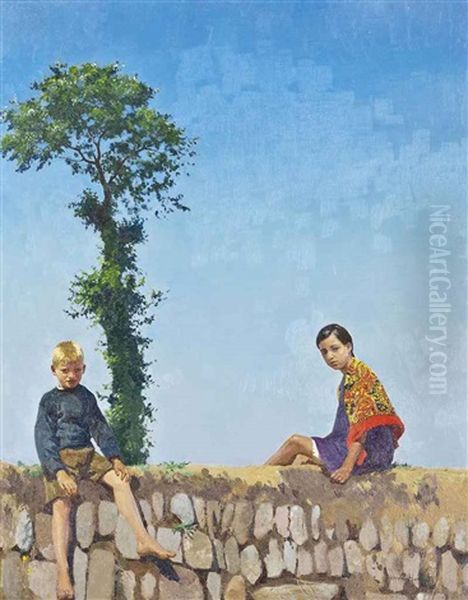
Light was a recurring preoccupation. Titles such as First Light suggest a specific interest in capturing transient moments and the atmospheric effects of different times of day. Noon in Summer likely explored the bright, potentially harsh light of midday. Across his work, there is a consistent engagement with how light defines form, creates mood, and reveals the textures of the Cornish environment. His religious paintings, less common but notable, often placed biblical scenes within familiar Cornish settings, featuring local people as models, thereby grounding the sacred in the everyday reality he knew so well.
Marriage and Artistic Circle
In 1911, Harold Harvey married Gertrude Bodinnor, who was also a painter associated with the Newlyn artistic community. Having a spouse who was also an artist likely provided mutual support and understanding within their household. While direct collaborative paintings are not commonly attributed to them, they shared the same artistic environment and undoubtedly discussed and influenced each other's work within the context of their life together in Newlyn.
Harvey worked alongside many other notable artists who were part of the Newlyn School or associated with the Cornish art scene during his lifetime. Besides the founding figures like Stanhope Forbes and Walter Langley, and his teacher Norman Garstin, his contemporaries included prominent artists such as Laura Knight and Harold Knight, known for their vibrant depictions of life behind the scenes at the ballet and circus as well as Cornish subjects. Alfred Munnings, famous for his equestrian paintings, also spent formative years in the Newlyn circle. Ernest Procter and Dod Procter were other significant figures, with Dod Procter achieving particular fame for her striking portrait Morning. Harvey's career connected the legacy of the early Newlyn pioneers with these later, often more modernist-influenced artists.
Exhibitions and Recognition
Harold Harvey achieved considerable recognition during his lifetime, exhibiting his work regularly and widely. He showed paintings at the prestigious Royal Academy of Arts (RA) in London, a key venue for artists seeking national recognition. He also exhibited with the Royal Institute of Oil Painters (ROI) and at the Goupil Gallery in London, known for showing progressive art. His work was also included in exhibitions held overseas, indicating a reputation that extended beyond British shores.
His connection with established art societies solidified his standing. He was elected an Associate Member of the Royal Cambrian Academy of Art (RCA) in Wales, holding this position from 1909 to 1913. Crucially, he was an active member of the Newlyn Society of Artists (NSA), participating in their local exhibitions from the 1910s through to the early 1930s. These affiliations placed him firmly within the recognised structures of the British art world.
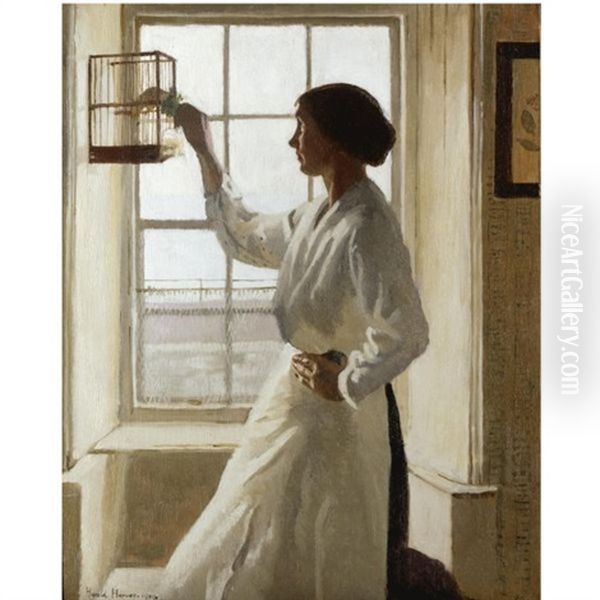
Despite this consistent exhibition record and participation in art societies, specific major awards are not prominently documented in his biography. However, the regular acceptance of his work at major venues like the RA and its acquisition by collectors and potentially museums (as suggested by the source material) attest to the esteem in which his work was held during his career. His reputation was primarily built on the consistent quality and appealing subject matter of his paintings.
Later Life and Legacy
Harold Harvey continued to live and work in Newlyn for the remainder of his life, remaining deeply connected to the community and landscape that had inspired him for decades. He passed away in Newlyn on May 19, 1941. By the time of his death, the heyday of the original Newlyn School had passed, and artistic styles had moved significantly towards Modernism. However, Harvey's work retained its appeal.
His legacy lies in his dedicated and sensitive portrayal of Cornish life over several decades. As a native Cornishman, his perspective offered a unique intimacy and understanding. He successfully navigated the transition from the Victorian realism of the early Newlyn School towards brighter, more modern aesthetics without losing his focus on local character. His paintings serve as important historical documents, capturing the fishing, farming, and mining industries, as well as the social fabric of the region, during the late 19th and early 20th centuries.
His work continues to be highly regarded, particularly by collectors interested in British Impressionism, the Newlyn School, and Cornish art. His paintings appear regularly at auction and are held in various public and private collections. While the source material mentions a student named "Norman Harvey" inheriting his style, his broader influence lies in his contribution to the rich artistic heritage of Cornwall and his consistent vision as a chronicler of its unique identity.
Art Historical Significance
In the broader narrative of international art history, Harold Harvey might occupy a more modest position compared to the major innovators of Modernism. However, within the context of British art and specifically the Newlyn School, his significance is undeniable. He is considered one of the key figures of the movement, particularly representing the artists born and raised in Cornwall who contributed to its development.
His importance stems from his ability to synthesize the observational realism inherited from the first generation of Newlyn painters with the brighter palettes and evolving compositional strategies influenced by French art and early Modernism. He maintained a commitment to representational painting and local subject matter throughout his career, providing a sustained and insightful look at a specific regional culture over a long period.
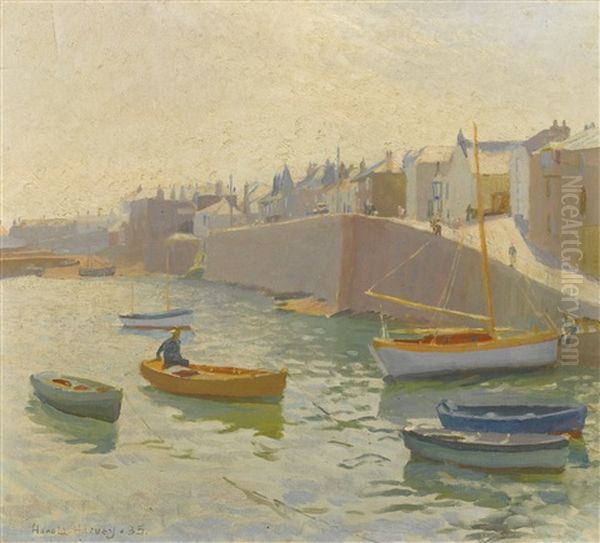
While perhaps not a radical innovator, Harvey was a highly skilled and sensitive painter whose work captured the unique light and atmosphere of Cornwall with great success. He documented a way of life that was already beginning to change, and his paintings offer a valuable window onto the past. His position as a bridge between the founding members of the Newlyn School, like Forbes and Langley, and later figures like the Knights and Procters, further solidifies his importance in the history of this influential British art colony. His work remains a testament to the enduring power of place in art.